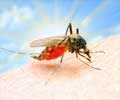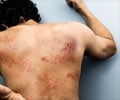Piperazine which is a drug used for deworming can be used as an antiviral agent to treat chikungunya.
TOP INSIGHT
Piperazine commonly used for deworming was tested for its anti-viral properties against Chikungunya and was found to be effective in relieving the symptoms and in fighting the infection.
Highlights:
- Anti-viral properties of the drug piperazine can be used to treat chikungunya.
- Piperazine is already in the market for use as deworming treatments against roundworm and pinworm.
- Instead of developing a new anti-viral agent, Piperazine can be used to reduce the symptoms of chikungunya and treat the infection.
Piperazine is already available in the market and is commonly used in deworming treatments against roundworm and pinworm. The drug was tested for its virus-fighting property and is confirmed to treat chikungunya. The effect of the drug for chikungunya is attributed to the binding property of capsid protein, present in the Chikungunya virus.
"Our research has showed that piperazine, a drug existing in the market, is successful in curbing the spread and replication of the Chikungunya virus in a lab setting. We are currently testing the molecule on animals hope to take this to clinical trials soon," said Tomar.
Using X-ray crystallographic technique, computational biology and fluorescence techniques the drug was found to be effective to fight viral infection.
Piperazine binds itself with a protein in the virus. There is a hydrophobic pocket on the protein called ;alphavirus capsid protein’ to which the virus binds. This pocket is crucial for the replication of the virus and its spread inside a host. This inhibition of the pocket prevents the spread of the virus and can help in treating the virus effectively using existing drugs.
What is Chikungunya?
Chikungunya virus, also known as Buggy Creek Virus, is transmitted by Aedes aegypti mosquito bites. The Aedes aegypti mosquito, a household container breeder and aggressive daytime biter which is attracted to humans, is the primary vector of chikungunya infection to humans.The virus transmits from mosquitoes to monkeys. Though other species can also be affected, monkeys are the main virus reservoirs. There is no evidence till date, to indicate that there is a person-to-person transmission of the virus causing chikungunya.
Symptoms of Chikungunya
Usually after the bite of the incubated mosquito, it takes 1-12 days for incubation. The symptoms of chikungunya include are categorized based on the severity of the disease.- High fever
- Pain in the joints, otherwise called arthralgia. The pain is usually severe in the morning and may subsidize during the day.
- Swelling of joints
- Vomiting, nausea
- Rash: fever rash appears in 50% of the cases within 5 days of the onset of the disease.
Chikungunya in Children
The symptoms vary in children ranging from asymptomatic to severe disease. Children can have minor hemorrhagic manifestations, edema in the lymph, swelling of eyelids and pharyngitis. Watery stools, seizures, lethargy, irritability and excessive crying in addition to fever.Chikungunya virus can be transmitted from the mother to the child and usually the transmission risk is greater during birth.
The signs of infection appeared around the fourth day and 90% of the infants recover.
Since the disease has severe outcomes, it is vital to treat the infection before the symptoms become severe. There are no specific drugs to cure chikungunya and the treatment given is aimed to relieve the symptoms. There are no effective vaccines developed to prevent chikungunya.
Bottom line
The treatment tested with Piperazine focused on relieving the symptoms associated with the infection. Since developing a new antiviral drug molecule can take over a decade the team used an existing, approved drug and tested to see if it might inhibit or kill pathogenic viruses.Reference:
- Dayaraj Cecilia, Current status of dengue and chikungunya in India, - (http://www.searo.who.int/publications/journals/seajph/seajphv3n1p22.pdf)
- Aggarwal M, Kaur R, Saha A, Mudgal R, Yadav R, Dash PK, Parida M, Kumar P, Tomar S. Evaluation of antiviral activity of piperazine against Chikungunya virus targeting hydrophobic pocket of alphavirus capsid protein, Antiviral Res. 2017, doi: 10.1016/j.antiviral.2017.08.015.
Source-Medindia
 MEDINDIA
MEDINDIA



 Email
Email






